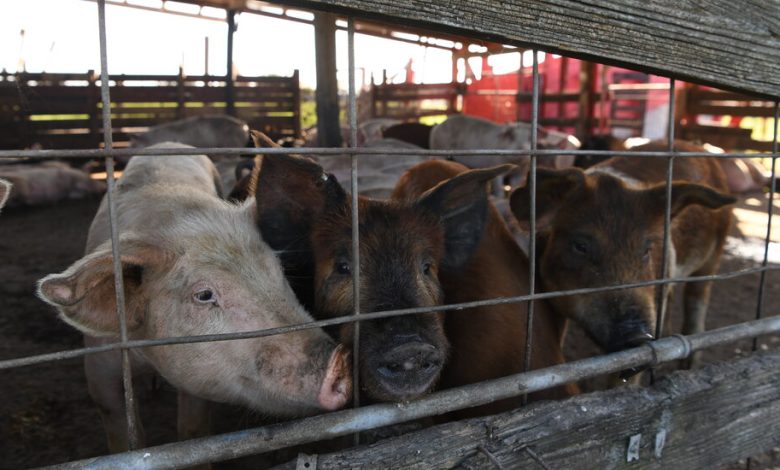Going Whole Hog for a Noche Buena Tradition

The Monday morning after Thanksgiving, Rogelio Sierra, who goes by Roy, sat at a wooden desk at the front of his hog slaughterhouse, La Casa Sierra, answering dozens of calls from customers ordering whole pigs for Christmas Eve.
“Tell me, papo. Four of them?” Mr. Sierra, 91, said into a speakerphone. He was talking to one of his regulars in Spanish, as workers pushed a rack of whole hogs waiting to be weighed and sent off to Miami by truck.
The customer laughed, and responded, “Turkey season is over.”

Rogelio “Roy” Sierra, 91, is from a rural area in Cuba and is the son of a butcher.Credit…Aileen Perilla for The New York Times
Once Thanksgiving is over, Christmas Eve, or Noche Buena, is the focus for many Latinos, a time when extended families come together for dinner and sometimes attend midnight Mass. Across Latin America dishes and customs can vary. In Mexico, tamales are the specialty on the table. For many Caribbean Latinos and Filipinos, roast pork or ham is a centerpiece throughout the holiday season, but that is especially true on Noche Buena, which translates to “good night.”
And the pork often comes from a slaughterhouse, like this one in Wimauma, Fla., about 30 miles from Tampa.
In Cuba, the Dominican Republic and Puerto Rico, pork is marinated in mojo — the citrus juice marinade with garlic and oregano that helps make the dish so succulent — then slowly cooked for hours in an oven, over a fire or in a Caja China roasting box. The presence of wild hogs in the Latin Caribbean stretches back centuries — Christopher Columbus brought pigs with him to Cuba in 1493.
These pigs became feral and contributed to famine because they ate tuber crops like ñame and taro that many people lived on. It wasn’t until people escaping enslavement in Cuba, the Dominican Republic and Puerto Rico began hunting them in the late 1800s and early 1900s that they became a major food source — and an income generator for these hunters. (Around that time, they were even sought out to help provide food for troops fighting in the Cuban War for Independence.)
For that reason, pork is viewed as a symbol of freedom, said Lauren Robin Derby, a Latin American studies professor at the University of California, Los Angeles.
The tradition of having pork on Christmas Eve dates to at least the 19th century. In Wimauma, an unincorporated area in Hillsborough County (which also includes Tampa), Mr. Sierra processes more than 500 pigs a week from Thanksgiving week to Christmas Eve.
Each day, Mr. Sierra sits at a wooden desk at the front of the slaughterhouse, directing a crew of 14 against a backdrop of photos of his younger self and his family. (He’s been married five times, and has said that all of his wives have been wonderful. His current wife, Lynh Huhn, he endearingly calls “La China.”) He’s a hardheaded business man, adamant that the slaughter, processing and delivery are done the way he wants.
Raising livestock and slaughtering pork are all Mr. Sierra has ever known. He grew up in Granma, in a rural area of Eastern Cuba, where his father was a farmer and a butcher, and he remembers watching his father slaughter and butcher 600-pound hogs as a child.
In 1956, Mr. Sierra, then 24, moved to Miami from Cuba. There, he worked at butcher shops, raised pigs and had several slaughterhouses. He’s been in the business for 47 years but has run this location of La Casa Sierra for 11 years, with a weeklong retirement in 2010 that didn’t stick. “It’s a hobby,” he said of his work. “Instead of playing golf, I stay here playing with my customers.”
He stopped processing the hogs himself only a few years ago when the U.S.D.A. inspector who oversees the facility told him it was getting dangerous at his age.
Mr. Sierra doesn’t raise his hogs at his facility. Instead, he buys them from Neely Livestock, a pig broker he’s worked with for decades, in Murfreesboro, Tenn., which sends hundreds of pigs every week. They roam on the pasture next to Mr. Sierra’s business before being selected for slaughter.
He makes his deals with a handshake. And he never makes promises he can’t keep, like guaranteeing a number of pigs or that a hog will be a certain weight.
Explaining the holiday demand to a customer ordering 15 pigs, he made that clear.
“I can’t promise anymore,” he said.
Follow New York Times Cooking on Instagram, Facebook, YouTube, TikTok and Pinterest. Get regular updates from New York Times Cooking, with recipe suggestions, cooking tips and shopping advice.




